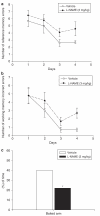Effects of the nitric oxide synthase inhibitor L-NAME on recognition and spatial memory deficits produced by different NMDA receptor antagonists in the rat
- PMID: 20664579
- PMCID: PMC3055326
- DOI: 10.1038/npp.2010.109
Effects of the nitric oxide synthase inhibitor L-NAME on recognition and spatial memory deficits produced by different NMDA receptor antagonists in the rat
Abstract
There is consistent experimental evidence that noncompetitive antagonists of the N-methyl-D-aspartate (NMDA) receptor, such as ketamine, MK-801, and phencyclidine (PCP), impair cognition and produce psychotomimetic effects in rodents. Nitric oxide (NO) is considered as an intracellular messenger in the brain. The implication of NO in learning and memory is well documented. This study was designed to investigate the ability of the NO synthase inhibitor L-NAME to antagonize recognition and spatial memory deficits produced by the NMDA receptor antagonists, MK-801 and ketamine, in the rat. L-NAME (1-3 mg/kg) counteracted MK-801- (0.1 mg/kg) and ketamine (3 mg/kg)-induced performance impairments in the novel object recognition task. L-NAME (10 mg/kg) attenuated ketamine (15 mg/kg)-induced spatial working memory and retention deficits in the radial water maze paradigm. L-NAME, applied at 3 mg/kg, however, disrupted rodents' performance in this spatial memory task. The present findings indicate (1) that L-NAME is sensitive to glutamate hypofunction produced by other than PCP NMDA antagonists such as MK-801 and ketamine and (2) that L-NAME alone differentially affects rodents' spatial memory.
Figures




Similar articles
-
Anesthetic ketamine impairs rats' recall of previous information: the nitric oxide synthase inhibitor N-nitro-L-arginine methylester antagonizes this ketamine-induced recognition memory deficit.Anesthesiology. 2011 Jun;114(6):1345-53. doi: 10.1097/ALN.0b013e318219524e. Anesthesiology. 2011. PMID: 21478733
-
Selective interaction of nitric oxide synthase inhibition with phencyclidine: behavioural and NMDA receptor binding studies in the rat.Behav Brain Res. 2005 Apr 15;159(1):95-103. doi: 10.1016/j.bbr.2004.10.006. Behav Brain Res. 2005. PMID: 15795002
-
Comparison of the amnestic effects of NMDA receptor antagonist MK-801 and nitric oxide synthase inhibitors: L-NAME and L-NOARG in goldfish.Behav Neurosci. 1998 Aug;112(4):892-9. doi: 10.1037//0735-7044.112.4.892. Behav Neurosci. 1998. PMID: 9733195
-
The effects of NMDA receptor antagonists and nitric oxide synthase inhibitors on opioid tolerance and withdrawal. Medication development issues for opiate addiction.Neuropsychopharmacology. 1995 Dec;13(4):269-93. doi: 10.1016/0893-133X(95)00140-9. Neuropsychopharmacology. 1995. PMID: 8747752 Review.
-
The N-methyl-D-aspartate antagonists phencyclidine, ketamine and dizocilpine as both behavioral and anatomical models of the dementias.Brain Res Brain Res Rev. 1995 Feb;20(2):250-67. doi: 10.1016/0165-0173(94)00014-g. Brain Res Brain Res Rev. 1995. PMID: 7795658 Review.
Cited by
-
Modulation of nitrergic signalling pathway by American ginseng attenuates chronic unpredictable stress-induced cognitive impairment, neuroinflammation, and biochemical alterations.Naunyn Schmiedebergs Arch Pharmacol. 2014 Feb;387(2):129-41. doi: 10.1007/s00210-013-0925-5. Epub 2013 Oct 17. Naunyn Schmiedebergs Arch Pharmacol. 2014. PMID: 24132508
-
The Nitric Oxide (NO) Donor Molsidomine Counteract Social Withdrawal and Cognition Deficits Induced by Blockade of the NMDA Receptor in the Rat.Int J Mol Sci. 2023 Apr 6;24(7):6866. doi: 10.3390/ijms24076866. Int J Mol Sci. 2023. PMID: 37047839 Free PMC article.
-
The nitric oxide donor sodium nitroprusside attenuates recognition memory deficits and social withdrawal produced by the NMDA receptor antagonist ketamine and induces anxiolytic-like behaviour in rats.Psychopharmacology (Berl). 2016 Mar;233(6):1045-54. doi: 10.1007/s00213-015-4181-x. Epub 2015 Dec 19. Psychopharmacology (Berl). 2016. PMID: 26685991
-
LY395756, an mGluR2 agonist and mGluR3 antagonist, enhances NMDA receptor expression and function in the normal adult rat prefrontal cortex, but fails to improve working memory and reverse MK801-induced working memory impairment.Exp Neurol. 2015 Nov;273:190-201. doi: 10.1016/j.expneurol.2015.08.019. Epub 2015 Sep 1. Exp Neurol. 2015. PMID: 26341392 Free PMC article.
-
Metaplastic effects of subanesthetic ketamine on CA1 hippocampal function.Neuropharmacology. 2014 Nov;86:273-81. doi: 10.1016/j.neuropharm.2014.08.002. Epub 2014 Aug 13. Neuropharmacology. 2014. PMID: 25128848 Free PMC article.
References
-
- Akbarian S, Bunney WE, Potkin SG, Wigal SB, Hagman JO, Sandman CA, et al. Altered distribution of nicotinamide-adenine dinucleotide phosphate-diaphorase cells in frontal lobe of schizophrenics implies disturbances of cortical development. Arch Gen Psychiatry. 1993;50:169–177. - PubMed
-
- Archer SL, Hampi V. NG-mono-methyl--arginine causes nitric oxide synthesis in isolated arterial rings: trouble in paradise. Biochem Biophysic Res Commun. 1992;188:590–596. - PubMed
-
- Bartolini L, Casamenti F, Pepeu G. Aniracetam restores object recognition impaired by age, scopolamine and nucleus basalis lesions. Pharmacol Biochem Behav. 1996;53:277–283. - PubMed
-
- Bernstein HG, Bogerts B, Keilhoff G. The many faces of nitric oxide in schizophrenia. A review. Schizophr Res. 2005;78:69–86. - PubMed
-
- Boultadakis A, Georgiadou G, Pitsikas N. Effects of the nitric oxide synthase inhibitor -NAME on different memory components as assessed in the object recognition task in the rat. Behav Brain Res. 2010;207:208–214. - PubMed
Publication types
MeSH terms
Substances
LinkOut - more resources
Full Text Sources

